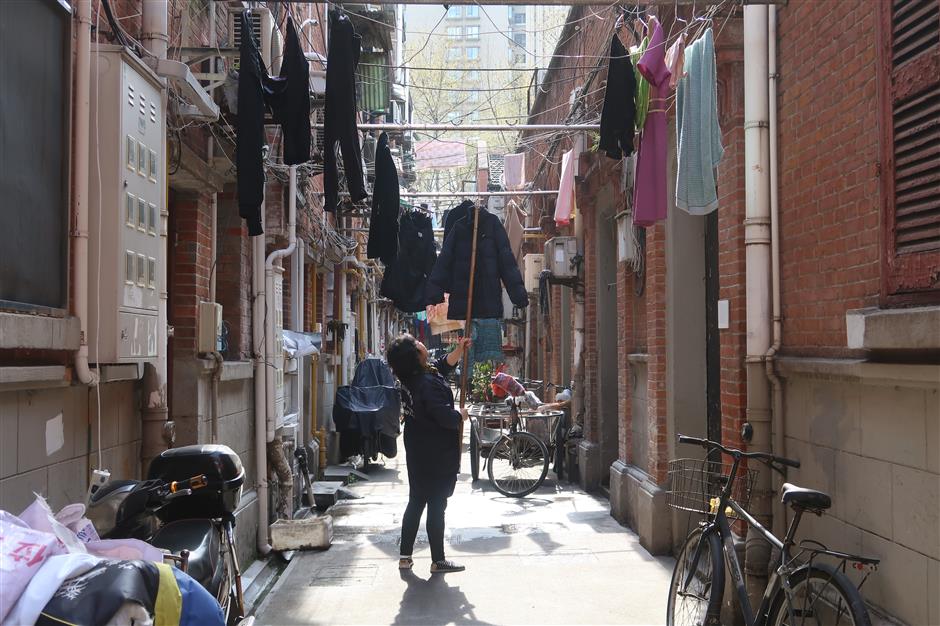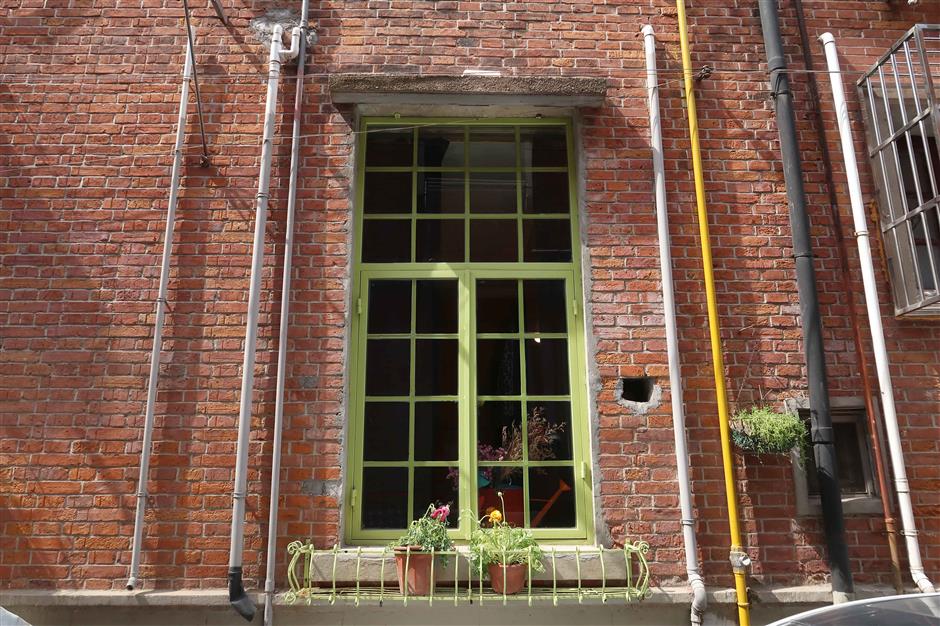French heritage, Chinese quintessence

The gate of Cité Bourgogne is a traditional Chinese arch decorated with gable-and-hip roofs and dougong bracket sets.

When I was a young student, I took bus No. 864 home every day. As it passed by the intersection of Shaanxi Road S. and Jianguo Road W., where Cité Bourgogne is located, I looked in fascination at the elaborate old gate to the neighborhood and wondered what lay behind it. Only recently did I find out.
The gate that so mesmerized me at a young age is a traditional Chinese arch, or paifang. It is 8.5 meters high and 6 meters wide, decorated with gable-and-hip roofs and dougong bracket sets. It is the entry to a lilong, or traditional alleyway housing, neighborhood of preserved shikumen (stone-gated) houses.
The enduring French name of the half-hectare area reminds me of its history: The neighborhood was designed by French merchants for residential use in 1930.
I entered Cité Bourgogne through the gateway on Shaanxi Road S., and the first place to greet me was a nameless hair salon. It was so dark and quiet that I felt a bit disconcerted. A middle-aged man suddenly emerged from a kitchen area that was once an electrical appliances repair shop some 10 years ago. He told me the hairdresser had gone out for a bit, so we chatted awhile.
He turned out to be a cleaner, surnamed Gu, who works in a nearby modern residential complex.
“The price of haircut is 15 yuan (US$2.38), while a perm might cost 50-60 yuan,” he informed me. “This place is always very busy because it’s popular with the elderly women living in the neighborhood.”
Gu pays 2,000 yuan a month to rent a 10-square-meter room in the neighborhood. He admitted it’s in a building badly need of some repair work.

An old man airs his quilt outdoors.

A woman hangs clothes to dry outdoors.

Exiting the shop, I saw that some of the buildings in the lane look different. They didn’t have the typical twin wooden doors painted black nor the facades of red brick. My interest was piqued and I pressed on to find answers.
“Nonghao (hi)!” is the local greeting. Residents cheerily ask, “Have you eaten lunch yet?” “Just came back?” “Where have you been?” “Such nice weather!” The conversations are natural and welcoming.
Walking along the lane, I saw clothes drying outside homes on cables. Shanghai people usually refer to clothes hanging outdoors as wanguoqi, or “flags of 10,000 countries.” Although the practice was once frowned upon, the clothes flapping in a breeze somehow inject a personal vitality to the community.
“It is a golden area for drying clothes,” said a man surnamed Ma. “Though many poles have been installed between the buildings to hang clothes, little air or sun gets in there because the distance between buildings is so close.”
Ma is a construction team leader from Chengdu, capital of Sichuan Province. I encountered him gardening in the lane. When he asked me to identify various plants, I flunked with every answer. The loquat, gardenias, orange trees and other plants don’t actually belong to Ma, but he tends them as if they were.
“When I am working outside or gone during Spring Festival, the elderly man living at No. 38 receives all my parcels, and all the couriers know that,” said Ma of the close ties in the neighborhood.
Ma said he decided to move to Cité Bourgogne four years ago because it was designated as a cultural heritage site in 1989 and wasn’t affected much by the fast urbanization.
“I had to move in the past due to urban redevelopment, and I didn’t want to do it again,” he explained. “What’s more, the transportation here is convenient.”
Sitting outside, Ma “chased” the sun, moving his chair up to three times a day to capture the warm rays.

An elderly man basks in spring sunshine in a lane.
Indeed, chairs are an omnipresent feature in a lilong neighborhood. Sitting beside a disused well, a nonagenarian granny plucked pills from clothing as she watched her son tend the plants.
To explore the indoor environment of shikumen architecture, I peeped through a crack in one door. At the same time, a man, holding a cigarette and a lighter opened the door at No. 36.
The man, surnamed Xu, said he was visiting his 94-year-old mother, who was taking a nap. He lived in Cité Bourgogne before relocating to Minhang District 10 years ago. Now, he comes back frequently to take care of his mother, who refuses to leave the old house and move to a modern apartment.
“My parents bought the house in 1946,” said Xu. “I think it cost them two gold bars. My mother doesn’t want to live with us elsewhere because she is used to the life here. She likes to sit out in the lane on sunny days, talking with neighbors.”
Xu recalled the days of his youth, when boys in the neighborhood played marbles in the lane and girls skipped rope.
“There once was a football field opposite to Cité Bourgogne,” he said. “Everyone contributed 0.02 yuan in order to pool money for the entrance fee.”
I asked him about the buildings that differed from traditional shikumen style.
“Ah, you noticed that,” he said with smile. “The ground floor of the buildings was originally used for parking, while servants lived on the second and third floors. They looked after the household children during the daytime and slept there at night.”

The Chinese character for happiness (xi) and couplets are a common sight in traditional neighborhoods.

An exquitely made mailbox

Ba Jin, a famous 20th-century Chinese writer, once lived at No. 52, where he wrote the article “A Dream of the Sea.” I decided to drop in at his former residence. Much to my surprise, the public area on the ground floor was dirty and disheveled. A gas stove was covered with a carton board, a refrigerator sat on a desk and two bicycles were parked inside the building.
Wang Ping, Party secretary of the neighborhood, later explained: “It is true that Ba Jin once lived on the ground floor of No. 52, but it was not for long and he rented rather than owned the house.”
So, no memorial there.
Cité Bourgogne comprises 73 buildings, according to Wang. There are 357 households and around 1,000 registered residences in the neighborhood, though half of them no longer live there.
The shikumen architecture may be a treasured heritage in Shanghai, but living in the old houses has its disadvantages.
“There are a lot of insects in the buildings,” said Xu while visiting his mother. “And my son once was scared by a rat there.”
As a construction expert, Ma told me the red-brick facades of the neighborhood are weathering badly, and wooden door and window frames succumb to peeling paint and decay.
Wang admitted that dampness is also a critical problem, and sewer pipes are so randomly placed that it’s difficult to remove overhead cables and bury them. “We need more expert help in regenerating Cité Bourgogne,” she said.

















